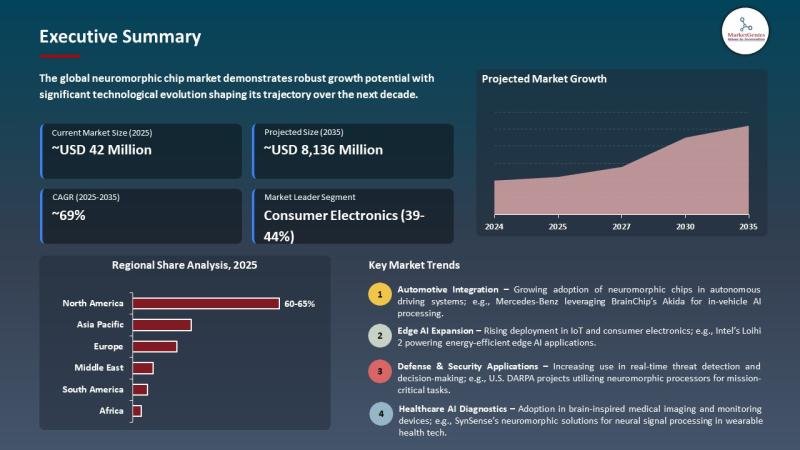
Neuromorphic Chip Market to Reach USD 8,136.3 Million by 2035, Driven by Edge AI and Ultra-Low-Power Brain-Inspired Architectures
The global Neuromorphic Chip Market is projected to grow from USD 42.6 million in 2025 to USD 8,136.3 million (USD 8.1363 billion) by 2035, expanding at a CAGR of 69.1% during the forecast period.
This explosive expansion is being driven by demand for energy-efficient, low-latency AI processing at the edge, increasing deployment in consumer electronics, and advances in brain-inspired architectures that enable always-on sensing and on-device learning.
MarketGenics positions neuromorphic chips as a critical class of hardware that closes the gap between conventional processors and brain-like computational efficiency – enabling real-time inference, adaptive learning, and dramatic reductions in power consumption for robotics, wearables, IoT, and other edge devices.
Get the Detailed Industry Analysis (including the Table of Contents, List of Figures, and List of Tables) – from the Neuromorphic Chip Market Research Report: https://marketgenics.co/press-releases/neuromorphic-chip-market-62622
Recent Developments Shaping the Market
BrainChip Launches Akida Cloud Platform (Sept 2025)
In September 2025, BrainChip unveiled the Akida Cloud Platform, aimed at accelerating neuromorphic model development and shortening customer integration cycles by offering cloud access to Akida’s neuromorphic toolchain and reference designs.
Intel’s Loihi and Hala Point Advances
Intel’s Loihi 2 and scaled systems such as Hala Point (announced in April 2024) exemplify silicon efforts to deliver large-scale neuromorphic capacity for research and select commercial workloads – combining increased neuron counts with improved on-chip learning capabilities.
IBM, Honda Collaboration on Neuromorphic & Chiplet R&D (May 2024)
In May 2024, Honda and IBM partnered to advance neuromorphic and chiplet technologies for software-defined vehicles, reflecting automotive interest in low-power, real-time perception and control.
Commercial and Research Deployments
BrainChip’s Akida is being integrated into wearables and robotics for on-device diagnostics and anomaly detection.
Innatera’s Pulsar (launched Aug 2025) targets always-on sensing for consumer devices.
Sandia National Laboratories’ deployment of SpiNNaker2 (June 2025) demonstrates large-scale neuromorphic simulation capability for complex modelling tasks.
BrainChip-Raytheon collaboration (April 2025) secured a contract with the U.S. Air Force Research Laboratory for neuromorphic signal-processing applications.
These developments underscore a maturing ecosystem spanning vendor commercialisation, research platforms, and defense/industrial pilots.
Market Forecast 2035
The market is expected to create a total forecasting opportunity of USD 8,093.7 million between 2025 and 2035.
North America is the most attractive region, accounting for 63.5% of 2025 revenue (USD 27.1 million), driven by strong R&D investment, early adopter customers in defense and industry, and an established startup and semiconductor ecosystem.
The consumer electronics segment holds the largest end-use share (~42%), reflecting demand for ultra-low-power, always-on intelligence in small devices.
To know more about the Neuromorphic Chip Market – Download our Sample Report: https://marketgenics.co/download-report-sample/neuromorphic-chip-market-62622
Key Drivers, Challenges, and Opportunities
Driver – Surge in Edge AI and Low-Power Requirements
Neuromorphic chips offer event-driven, sparse-compute models that execute inference and on-chip learning with orders-of-magnitude lower energy than conventional processors – a decisive advantage for battery-constrained edge devices in robotics, wearables, and smart sensors.
Restraint – Scalability and Limited Developer Ecosystem
Commercial scale-up faces hurdles: neuromorphic architectures require specialized toolchains, novel programming models, and cross-disciplinary expertise (neuroscience + computer engineering). The small pool of developers and limited software maturity slow adoption and increase integration costs.
Opportunity – Consumer Electronics and On-Device Diagnostics
Embedding neuromorphic processors into consumer devices (smartphones, cameras, wearables, smart home sensors) presents a major runway. Use cases such as always-on vision, anomaly detection, and privacy-preserving diagnostics can unlock broad commercial demand while avoiding cloud latency and bandwidth costs.
Key Trend – Emergence of Brain-Inspired Architectures and On-Chip Learning
Neuromorphic designs that emulate synaptic plasticity and spiking neural behaviour are enabling event-based sensing and continuous learning on device.
Products and platforms (e.g., Akida, Loihi, NorthPole) emphasise low latency, sparse computation, and power efficiency – making them attractive for real-time control, robotics, and adaptive sensing applications.
Segmental Insights
Consumer Electronics Lead Adoption
The consumer electronics vertical accounts for roughly 42% of demand in 2025, driven by applications that require real-time responsiveness and long battery life (smart cameras, wearables, AR/VR peripherals, drones).
Neuromorphic solutions enable features such as event-camera processing and always-on anomaly detection without continuous cloud dependence.
North America Dominance
North America’s leadership stems from concentrated R&D, defense and industrial pilots, and early commercial adopters.
Strategic partnerships and national lab deployments (e.g., Sandia’s SpiNNaker2) further cement the region’s edge in both research scale and practical integration.
Buy Now: https://marketgenics.co/buy/neuromorphic-chip-market-62622
Competitive Landscape
The neuromorphic chip market is moderately consolidated, with the top five players accounting for over 55% of market share in 2025.
Key market participants cited in the report include BrainChip, Intel, IBM, Qualcomm (in related edge AI activities), and emerging silicon vendors such as Innatera.
The competitive dynamic blends specialist neuromorphic startups, established semiconductor firms extending into brain-inspired designs, and system integrators partnering for domain-specific solutions.
Future Outlook
By 2035, neuromorphic chips are expected to transition from niche research platforms to widespread edge AI accelerators for always-on applications, augmenting – rather than replacing – conventional accelerators where event-driven, ultra-low-power processing is required. Growth vectors include:
Developer ecosystems and tooling that simplify programming and model portability;
Application verticalisation (consumer electronics, healthcare wearables, robotics, defense sensors);
Hybrid architectures combining neuromorphic co-processors with conventional NPU/GPU fabrics for task-specific efficiency;
Commercial cloud tooling and marketplaces (e.g., Akida Cloud) to lower integration barriers.
These advances will unlock the value proposition of brain-inspired computing: energy-efficient, adaptive intelligence at scale.
Prominent Companies Operating in the Global Neuromorphic Chip Market (as cited in the report):
BrainChip, Intel, IBM, Qualcomm, Innatera, Sandia/SpiNNaker (research platform), and other niche neuromorphic innovators.
Get a preview of our Neuromorphic Chip Market Playbook – your guide to GTM strategy, competitive intelligence, supplier dynamics, and Consumer Behavior Analysis: https://marketgenics.co/playbook/neuromorphic-chip-market-62622
About Us
MarketGenics is a global market research and management consulting company empowering decision makers across healthcare, technology, and policy domains. Our mission is to deliver granular market intelligence combined with strategic foresight to accelerate sustainable growth.
We support clients across strategy development, product innovation, healthcare infrastructure, and digital transformation.
Contact:
Mr. Debashish Roy
MarketGenics India Pvt. Ltd.
800 N King Street, Suite 304 #4208, Wilmington, DE 19801, United States
USA: +1 (302) 303-2617
Email: sales@marketgenics.co
Website: https://marketgenics.co
This release was published on openPR.

















